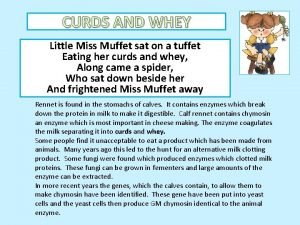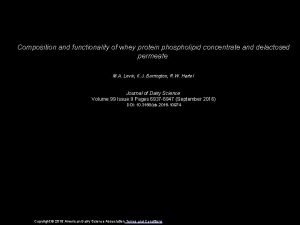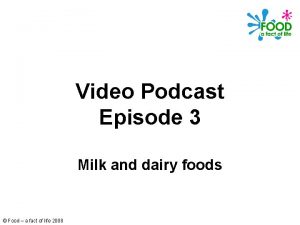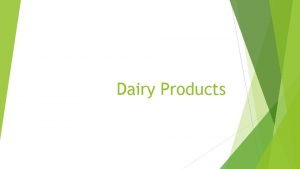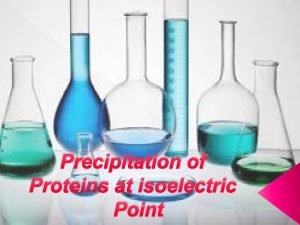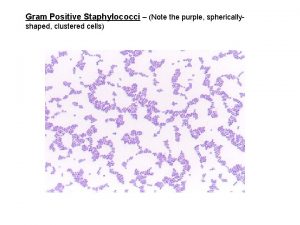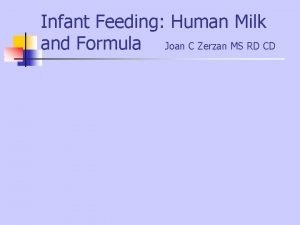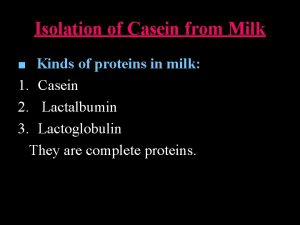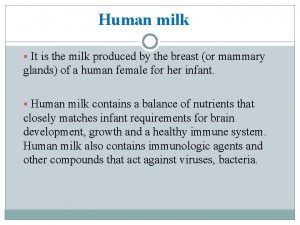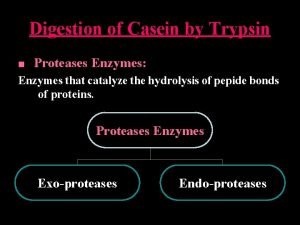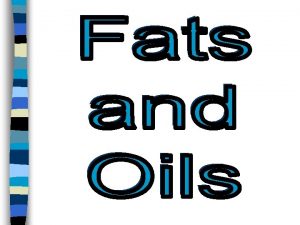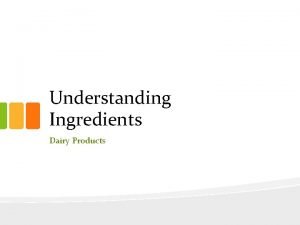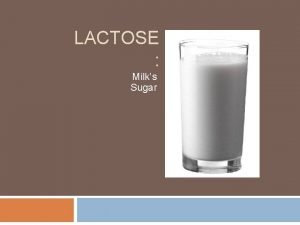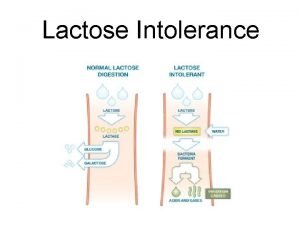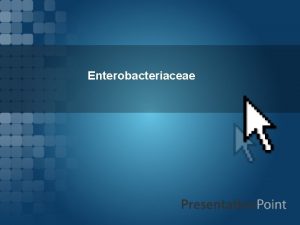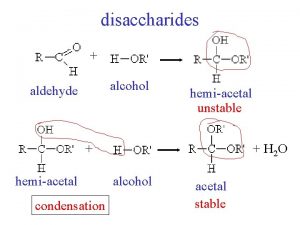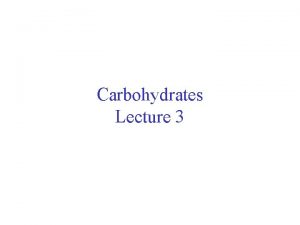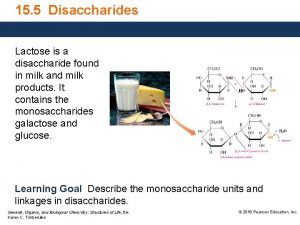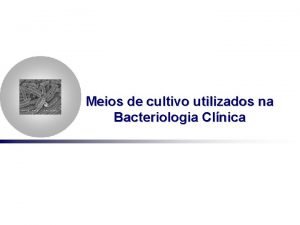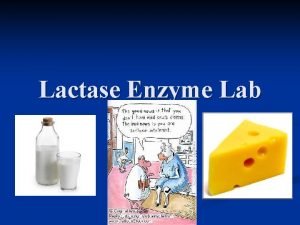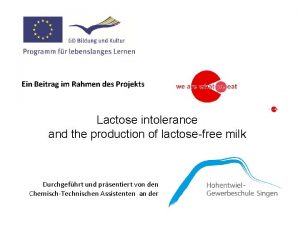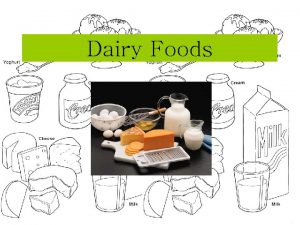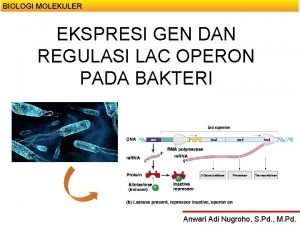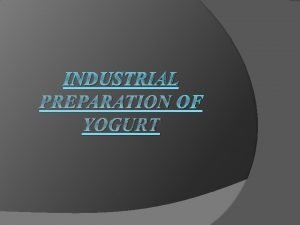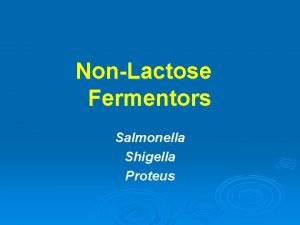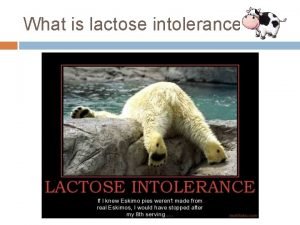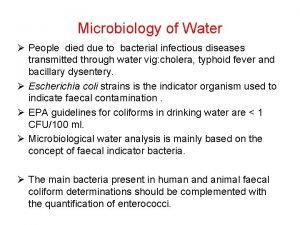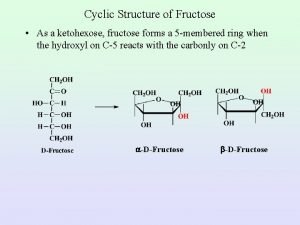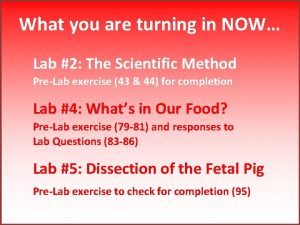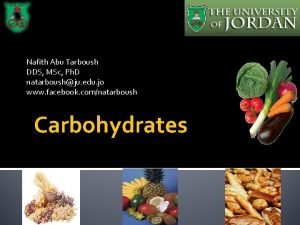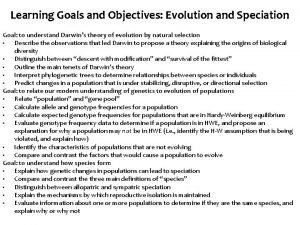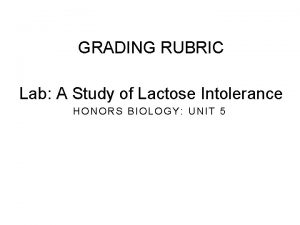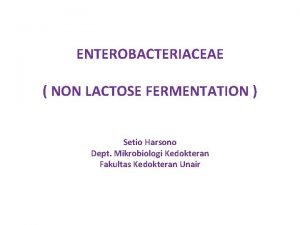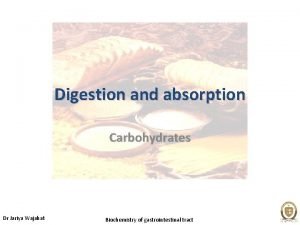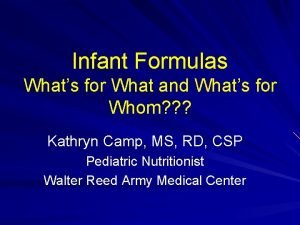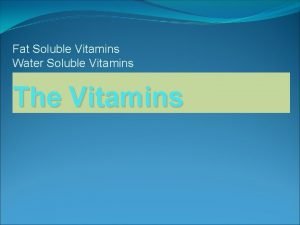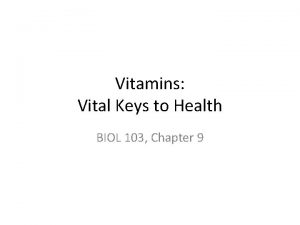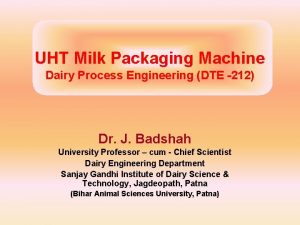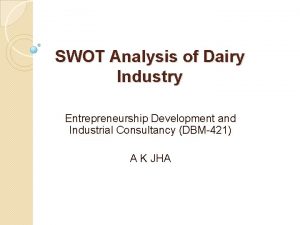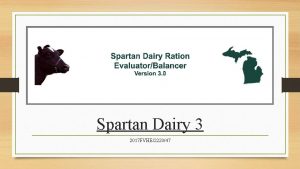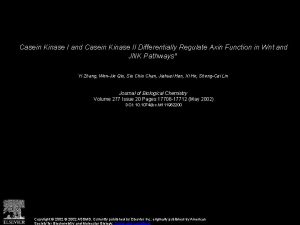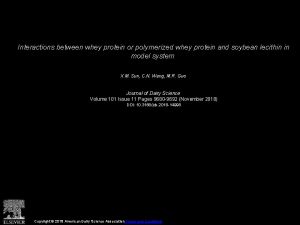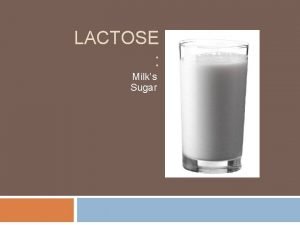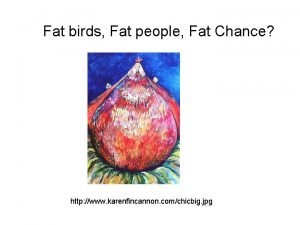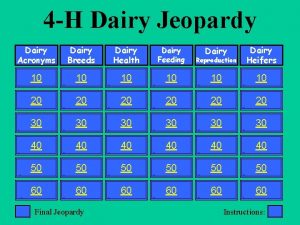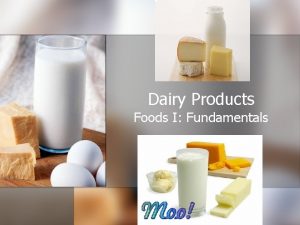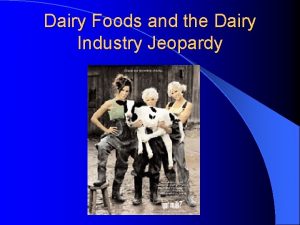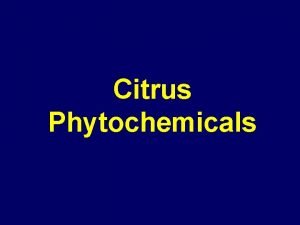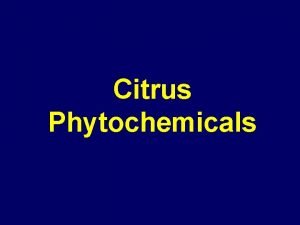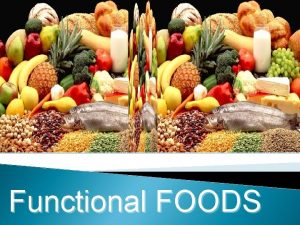Dairy Foods Species Water Fat Casein Whey Lactose





















































- Slides: 53

Dairy Foods


Species Water Fat Casein Whey Lactose Ash Energy Human 87. 1 4. 5 0. 4 0. 5 7. 1 0. 2 72 Rat 79. 0 10. 3 6. 4 2. 0 2. 6 1. 3 137 Dolphin 58. 3 33. 0 3. 9 2. 9 1. 1 0. 7 329 Dog 76. 4 10. 7 5. 1 2. 3 3. 3 1. 2 139 Horse 88. 8 1. 9 1. 3 1. 2 6. 2 0. 5 52 Cow 87. 3 3. 9 2. 6 0. 6 4. 6 0. 7 66 Deer 66. 7 18. 0 8. 6 1. 5 2. 8 1. 5 214 Milk is for mammals the main nutritive source for the young while they have their greatest relative growth. Therefore the amount of milk and its composition produced by the lactation animal is very well adapted to the special needs of the young. The variation in milk composition between species is various

Lactation curves of various species 1. 7 ml/g body

p The modern lactating dairy cow has a much higher milk production than the calf needs. This is the result of the genetic breeding programs and the great improvements in feeding and management. Furthermore, the consumer demands on milk composition are not fully related to the biological capacity of the ruminants. Consumers and the dairy industry prefer a milk with a low fat content and high protein content. Therefore efforts are made to produce such a milk through breeding and by feeding. This alteration of milk yield and milk composition puts special demands on the modern lactating dairy cow.

Milk Production




Milk Science 우유의 성분 비유기 (lactation stage), 연령, 계절, 착유간격, 사료, 환경온도, 질병 이 주요한 영향을 미친다. Composition can vary according to: 1. Species 2. Strain or breed of animal 3. Stage of Lactation 4. Stage of milk removal Milk fat is the most variable component. Lactose is the least variable component.

Lactose • is the major carbohydrate in milk. • is present in milk of most mammals. • is a readily digestible source of glucose (energy) for the neonate. • is digested by lactase enzyme in the neonate. • is unique to the mammary gland. • is the major osmole of milk (the primary component that draws water into the gland). Lactose is a disaccharide composed of D-galactose and D-glucose.

Lactose Intolerance Lactose Lactase Galactose + Glucose

Lactose is the major osmole in milk There is no gradient of water maintained between blood and milk. Cell membranes act to restrict diffusion of water. Cell membranes are semipermeable, that is they permit water to move across, but not many solutes move freely across cell membranes. Osmosis - the spontaneous flow of water across a membrane, down a concentration gradient of water. Osmotic pressure - the pressure required to prevent osmotic flow (osmosis of water into a given solution). Isosmotic - When two solutions with the same osmotic pressure are isosmotic

Milk Fat : is primarily triglycerides. - 3 fatty acids bound to 1 glycerol is initially used by neonate for deposition of body adipose is an energy source for the neonate. is secreted as a milk fat globule. - bounded by a lipid-bylayer membrane is extremely variable in concentration between species and within a species. is dispersed when milk is homogenized.

Milk Fat Adipocytes of the mammary fat pad. These fat cells are similar to the body adipose cells. Note the broad sheaths of dense connective tissue (stained red in this image) that course through the lobules of adipocytes. Milk fat is composed of a complex mixture of lipids. Triglycerides are the major type of lipid in milk fat. Triglycerides are composed of three fatty acids covalently bound to a glycerol molecule by ester bonds. Milk fat is the major source of lipid used by the neonate mammal for accumulating body adipose in the initial days after birth. Most mammalian neonates are born with little body adipose for insulation or as a source of stored energy. A few days after birth most neonates begin to be able to metabolize milk fat as an energy source.

Fat globule • If milk is left to stand, a layer of cream forms on the surface. The cream differs considerably in appearance from the lower layer of skim milk. • Under the microscope cream can be seen to consist of a large number of spheres of varying sizes floating in the milk. Each sphere is surrounded by a thin skin—the fat globule membrane—which acts as the emulsifying agent for the fat suspended in milk • The membrane protects the fat from enzymes and prevents the globules coalescing into butter grains. The fat is present as an oil-in-water emulsion: this emulsion can be broken by mechanical action such as shaking

Milk Fat Milk fat is the primary component of cream. Below milk was centrifuged to separate the cream and the skim milk (also called the plasma phase of milk). Milk fat is secreted from mammary epithelial cells as fat globules which are primarily composed of a globule of triglyceride surrounded by a lipid bilayer membrane similar to the apical membrane of the epithelial cells (discussed in more detail in the Lesson on Milk Fat Synthesis). This fat globule membrane helps to stabilize the fat globules in an emulsion within the aqueous environment of milk (remember that cow milk is about 87% water). Lipid has a lower buoyant density than water, so when raw milk is centrifuged the fat rises to the top resulting in the cream layer (see image at right).

Milk Proteins • There are several types of proteins in milk. • The major milk proteins are unique to milk. - not found in any other tissue • Milk proteins, particularly caseins, have an appropriate amino acid composition for growth and development of the young. • Other proteins in milk include an array of enzymes, proteins involved in transporting nutrients, proteins involved in disease resistance (antibodies and others), growth factors, etc. Casein 78. 3%, albumin 9. 1%, globulin 3. 5%, proteose-peptone 4. 1, non -protein nitrogen compounds 5. 0%

Proteins (30 -35 g/l) Minor protein Caseins (76 -86%) Α-casein (60%) β-caseins (25 -35%) γ-caseins (3 -7%) Enzymes • Whey protein (14 -24%) • Lactoglobulin (7 -12%) • Lactalbumin (2 -5%) • Immunoglobulins (1. 3 -2. 7%) • Blood serum albumin (0. 7 -1. 3%) • Proteose-peptones (2 -6%)

Caseins is composed of several similar proteins which form a multi-molecular, granular structure called a casein micelle. -the casein micelle contains water and salts (mainly calcium and phosphorous). -Some enzymes are associated with casein micelles. The micellar structure of casein in milk is an important -the mode of digestion of milk in the stomach and intestine -the basis for many of the milk products industries (such as the cheese industry) -the basis for our ability to easily separate some proteins and other components from cow milk. Casein is one of the most abundant organic components of milk, in addition to the lactose and milk fat. Individual molecules of casein alone are not very soluble in the aqueous environment of milk. However, the casein micelle granules are maintained as a colloidal suspension in milk. If the micellar structure is disturbed, the micelles may come apart and the casein may come out of solution, forming the gelatinous material of the curd. This is part of the basis formation of all non-fluid milk products like cheese

Milk Centrifugation Casein Whey Water non-casein protein lactose Acid, proteolytic enzyme (rennin) Curd Whey Casein Water non-casein protein lactose

Foods from Milk… based on its scientific facts Whole milk solids Fat Protein p. H 4. 6 Separate milk Cream 35% fat Churn cream Lactose Precipitate Casein Butter 82% fat Remove moisture Supernatant Whey protein Whey Butter or oil 99% fat Hard cheese bacterial fermentation Cottage cheese Lactic acid acetic acid propionic acid aldehydes


시유 (market milk) Measurement Inspection Clarification Standardiza표준화 tion Distribution Inspection Storage (Aging) Packaging Homogenization Pasteurization

Clarification



Standardization

Quiz What is differences between MA and CA storage p Explain the minimally process with examples. p p Available day and time ?

Homogenization p p 1. 2. 3. 4. Milk is an oil-in-water emulsion, with the fat globules dispersed in a continuous skimmilk phase. If raw milk were left to stand, however, the fat would rise and form a cream layer. Homogenization is a mechanical treatment of the fat globules in milk brought about by passing milk under high pressure through a tiny orifice, which results in a decrease in the average diameter and an increase in number and surface area, of the fat globules. a decrease in the mean diameter of the fat globules (a factor in Stokes Law), a decrease in the size distribution of the fat globules (causing the speed of rise to be similar for the majority of globules such that they don't tend to cluster during creaming), and an increase in density of the globules (bringing them closer to the continuous phase) oweing to the adsorption of a protein membrane. In addition, heat pasteurization breaks down the cryo-globulin complex, which tends to cluster fat globules causing them to rise






시유-검사법 지방함량 측정 : babcock milk test 1. Measure milk into graduated test tube. You usually take 18 grams of milk or 17. 6 milliliters. 2. Add 17. 6 milliliters of 90 -92% sulfuric acid. 3. Centrifuge at 50ºC. 4. Measure fat which will be floating on top of liquid in the test tube 우유의 열안정성과 신선도 판단: alcohol test 1. 2. 3. 4. 5 ml milk into testtube 5 ml of ethyl alcohol (68%) and mix Coagulation means acidity is over 0. 21% Test should be carried out below than 15 C

발효유-액상요구르트 원료의 살균: 탈지유를 원료로 10 -12% 고형분 UHT, 90 C, 15 -60 min. 115 C, 1 min. cooling 접종, 배양: 별도로 배양된 starter 를 원료액에 대해 2 -2. 5% 첨가후 교반 Starter: Str. Lactis, Str. Cremoris, Str. Thermonphilus Lactobacillus bulgaricus, L. acidophilus, L. casei 균질화, 조합: curd 를 homogenizer 로 균질화한후 당, 향기첨가 충진, 냉각:

발효유-고형요구르트 원료의 처리: 탈지유를 원료로 12 -15% 고형분 gelatin, agar (thickening agent) 0. 1 -0. 5% Vitamin, sugar, syrup 90 C, 20 -30 min. 94 C, 15 min. 115 C, 1 min. cooling 접종, 배양: 별도로 배양된 starter 를 원료액에 대해 2 -3% 첨가후 교반 Starter: Str. Lactis, Str. Cremoris Lactobacillus bulgaricus, L. acidophilus Curd 형성 0. 85 -0. 95 (p. H 4. 4 -4. 5) 형성 (*활성균주는 더 빠름) 충진, 냉각:









동영상: Cheese

동영상: Butter


보충: 소화흡수 Enzymes for all three classes of foods are secreted by the pancreas in an inactive form.

보충: 소화흡수 Enzymes for all three classes of foods are secreted by the pancreas in an inactive form. Glucose and galactose are absorbed in a process that requires Na, fructose is absorbed through its own channel by facilitated diffusion. Since these cells are transporting glucose, they seem to use a different substrate for their own metablism -the amino acid glutamine. Lactose, milk sugar, is composed of glucose and galactose. The enzyme that digests lactose is lactase, it is secreted in juvenile mammals, but levels usually decline in adults leading to lactose intolerance.

보충: 소화흡수 Proteins are absorbed as amino acids in a process that also requires sodium, 2 and 3 AA units, and small peptides by endocytosis. In babies, more, larger peptide units are absorbed whole, the infant can absorb the large immune globulins found in mother's milk. Both sugars and amino acids are absorbed by the capillary circulation of the villi and carried via the hepatic portal system for processing

보충: 소화흡수 Fats are digested in the small intestine, with the help of the bile salts. Micelles of triglycerides are still hydrophobic enough to cross the lipid bilayer of the absorptive cells. In the cells they are processed and repackaged by the smooth endoplasmic reticulum and the golgi and are released as chylomicrons. These packages are not able to enter capillary circulation, but are absorbed by the lymph vessels of the villus -the lacteals.
 Curds and whey little miss muffet
Curds and whey little miss muffet Whey protein phospholipid concentrate
Whey protein phospholipid concentrate Whey god
Whey god Description nutella
Description nutella Water and water and water water
Water and water and water water Dairy foods list
Dairy foods list Frozen milk products
Frozen milk products Isoelectric point precipitation
Isoelectric point precipitation Microbiology gram stain
Microbiology gram stain Casein hydrolysate formula
Casein hydrolysate formula Isolation of casein from milk principle
Isolation of casein from milk principle Casein in human milk
Casein in human milk Casein and trypsin
Casein and trypsin Trans fat vs cis fat
Trans fat vs cis fat Visible fat and invisible fat examples
Visible fat and invisible fat examples Keystone species plants
Keystone species plants Raw milk fat percentage
Raw milk fat percentage Pont oxydique définition
Pont oxydique définition Lactose is made up of
Lactose is made up of Causes of lactose intolerance
Causes of lactose intolerance Sucrosazone
Sucrosazone Lactose intolerance by country
Lactose intolerance by country Antigenic structure of e coli
Antigenic structure of e coli Hemiacetal in lactose
Hemiacetal in lactose Physical and chemical properties of monosaccharides
Physical and chemical properties of monosaccharides A disaccharide found in milk and milk products
A disaccharide found in milk and milk products Lactose
Lactose Lactose positiva
Lactose positiva Lactose
Lactose Lactose intolerance scale
Lactose intolerance scale Lactose
Lactose Lactose glycemic index
Lactose glycemic index Gen
Gen Lactobacillus bulgaricus converts lactose to *
Lactobacillus bulgaricus converts lactose to * Proteus non lactose fermenter
Proteus non lactose fermenter Lupinesse
Lupinesse Fisiopatologia intolerancia a lactose
Fisiopatologia intolerancia a lactose Double strength lactose broth
Double strength lactose broth Lactose intolerance histology
Lactose intolerance histology Fructose is a ketohexose.
Fructose is a ketohexose. Interpret
Interpret Structure of sucrose maltose and lactose
Structure of sucrose maltose and lactose Reproductive isolation
Reproductive isolation Enzymes and lactose intolerance lab answers
Enzymes and lactose intolerance lab answers Enterobacteriaceae non lactose fermenter
Enterobacteriaceae non lactose fermenter Symptoms of lactose intolerance
Symptoms of lactose intolerance Enfa lactose free
Enfa lactose free Scorbutic rosary
Scorbutic rosary Water soluble vitamins vs fat soluble vitamins
Water soluble vitamins vs fat soluble vitamins Uht milk machine
Uht milk machine Dairy food pyramid
Dairy food pyramid Swot analysis of dairy industry
Swot analysis of dairy industry Sundale dairy
Sundale dairy Sparta dairy
Sparta dairy
